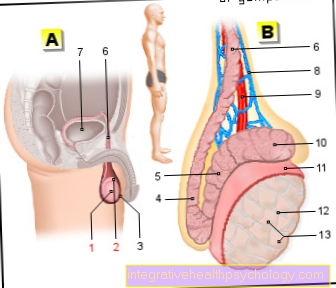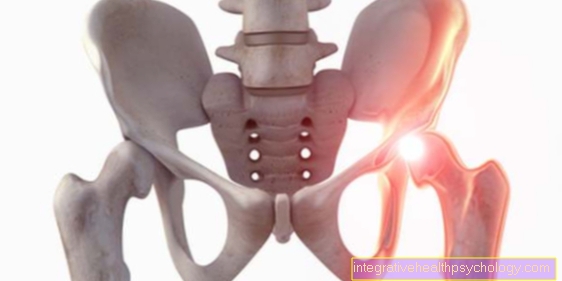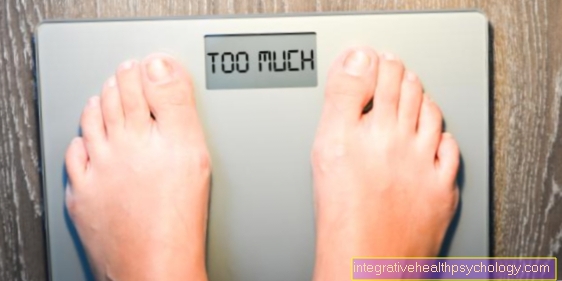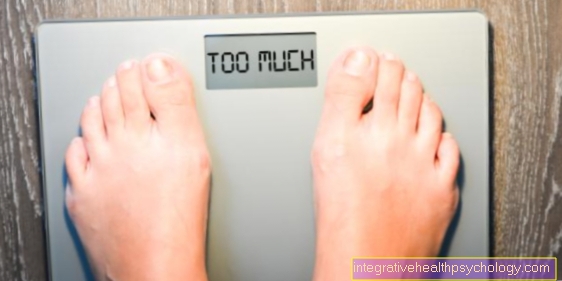These are the symptoms that help you recognize colon polyps
introduction
Intestinal polyps are protuberances on the intestinal wall that, depending on their size, can cause more or less pronounced symptoms. In most cases, intestinal polyps are symptom-free and do not cause any discomfort.
Such polyps are often found incidentally during a colonoscopy (Colonoscopy) discovered.
However, large polyps often show up as bleeding and abdominal pain. Since colon cancer can develop from colon polyps, they must be removed. This is done by means of Endoscopyduring a colonoscopy. No further therapy is usually necessary after the removal.

Overview of the symptoms
Colon polyps usually cause no symptoms and are often discovered by accident. Above all, however, larger intestinal polyps lead to complaints in the gastrointestinal tract. The symptoms include:
-
Constipation or diarrhea
-
Hidden or visible bleeding in the stool
-
stomach pain
-
Discoloration of the stool
-
Traces of mucus in the stool
-
Flatulence
stomach pain
Abdominal pain is a common symptom with larger intestinal polyps. The growths on the intestinal mucosa can lead to abdominal cramps and pain in the lower abdominal region. Those affected describe the abdominal pain as pulling or stabbing.
The abdominal pain often occurs in combination with irregular bowel movements (constipation or diarrhea). Severe abdominal cramps can also lead to nausea and vomiting.
People who have had these symptoms for a long time should see a doctor as they may be colon polyps. The doctor will do a colonoscopy to diagnose the polyps.
In the worst case, very large intestinal polyps can impede the passage of stool in the intestine and cause an intestinal obstruction (Ileus) cause. The affected patients then suffer from severe colicky pain and must be treated immediately.
Read more on this topic at: Bowel obstruction - these are the signs
Blood in the stool
Sometimes an intestinal polyp can bleed easily, which can lead to blood in the stool. Typically, intestinal polyps bleed quite irregularly, which means the stool is not always bloody. Small amounts of blood are usually deposited on the outside of the stool, but larger amounts of blood are also possible.
The color of the blood indicates how current the bleeding is in the intestine.
If the bleeding is fresh, the blood in the stool is bright red. If the blood remains in the intestine for a long time, it is broken down and turns dark to black.
However, those affected often do not notice that there is blood in the stool. Then one speaks of occult Blood in the stool, i.e. blood that is not visible to the naked eye. With a special test, the Haemoccult test (Guaiac test) the hidden blood can be detected in a stool sample.
If colon polyps continue to bleed over a long period of time, the person is constantly losing blood in the stool. As a result, permanent blood loss can lead to anemia (anemia) and the associated symptoms. Patients are pale, constantly feeling tired, and complaining of exhaustion.
Read more on this topic at: Blood in the stool
Discoloration of the stool
In healthy people, the stool is usually light to dark brown in color.
A dark or even black discoloration of the stool can indicate blood contamination and should be clarified by a doctor.
A hemoccult test can tell if there is blood in the stool. Larger colon polyps can occasionally bleed and lead to blood in the stool.
If the blood stays in the intestine longer, it changes color from light red to black. The reason for this is the iron-containing heme, an important component of blood that is broken down in the intestine and turns the blood black. So stool discoloration can be a symptom of colon polyps and requires a doctor's visit.
mucus
Some colon polyps produce mucus. This can be seen from the fact that the detached stool has whitish deposits of mucus. The mucus is made up of water and electrolytes.
Depending on the composition, the slime can have a different consistency. Polyps cause thick, sticky, liquid, or transparent mucus.
Mucus in the stool can indicate polyps or another bowel disease, but in many cases the mucus is completely harmless. A doctor can examine the stool sample and determine the cause of the mucus production.
Are you interested in this topic? You can read more about this in our next article: Slimy stool
diarrhea
The larger an intestinal polyp, the more likely it is to cause problems with bowel movements. A common symptom of some intestinal polyps is therefore recurrent, mushy to watery diarrhea for which there is no other explanation (such as intestinal flu or food poisoning).
The diarrhea can be mixed with blood or mucus, a change between diarrhea and subsequent constipation is also possible and can be a symptom of intestinal polyps.
constipation
Very large polyps can interfere with the passage of stool through the bowel by creating a mechanical blockage in the bowel. The result is blockages (Constipation).
In severe cases, the obstacle can lead to a complete bowel obstruction (Ileus) come.
Those affected then suffer from stool retention and very severe abdominal pain. This is an absolute emergency situation that requires immediate medical attention.
Read more on this topic at: Bowel obstruction - these are the signs
Flatulence
Sometimes an intestinal polyp also causes gas. However, this is a relatively unspecific symptom that can be traced back to many causes.
However, when combined with stool irregularities, blood in the stool, and abdominal pain, flatulence can be a sign of intestinal polyps.
This is how you can recognize malignant intestinal polyps
There are different forms of colon polyps.
What they all have in common is that they consist of protrusions of the intestinal mucosa.
The majority (about 90%) of the polyps are so-called adenomatous polyps.
Adenomatous Colon polyps are tumor precursors and therefore carry the risk of being able to degenerate neoplastically. That means they may develop into colon cancer. It is assumed that around 5% of all colon polyps develop into tumors, which is why regular colonoscopy checks are necessary.
Read more about this at: Types of colon polyps
Malignant intestinal polyps are difficult to separate from harmless polyps based on symptoms. In addition to blood in the stool, recurring abdominal cramps and changes in bowel behavior (diarrhea or constipation), there is an inexplicable weight loss. Loss of appetite and decreased performance can also occur.
Malignant polyps can only be reliably identified with a colonoscopy. The doctor removes suspicious intestinal polyps endoscopically, i.e. during the colonoscopy, and then sends them to a pathologist who analyzes the tissue sample for tumor cells under the microscope.
Read more about this at: Colon polyp therapy





























